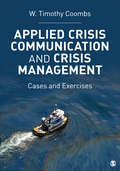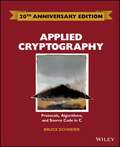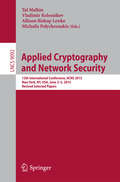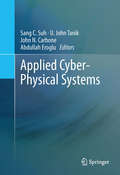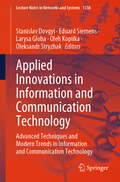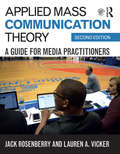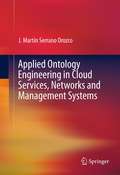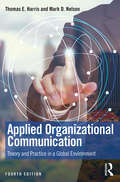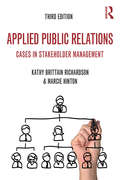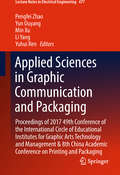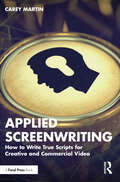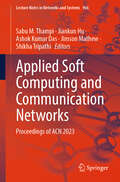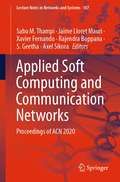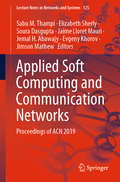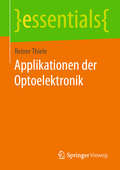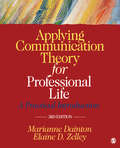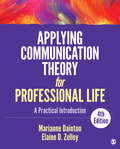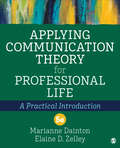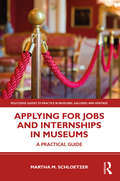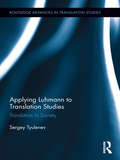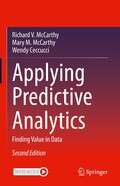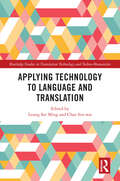- Table View
- List View
Applied Conversation Analysis
by Charles AntakiMuch of everyday work is done through talk between practitioner and client. Conversation Analysis is the close inspection of people's use of language in interaction. The work reported in this collection shows how CA can be used to identify, and improve, communicative practices at work.
Applied Crisis Communication and Crisis Management: Cases and Exercises
by Timothy CoombsDesigned to give students and public relations professionals the knowledge and skills they need to become successful crisis managers, this practical book includes a wide range of cases that explore crisis communication and management in action. In the first two chapters, the author introduces key theories and principles in crisis communication, which students apply by analyzing 17 cases drawn from recent headlines. Cases are explored from pre-crisis, mid-crisis, and post-crisis communication perspectives, and include a range of predominant crisis scenarios from product recalls to lawsuits to environmental disasters
Applied Cryptography and Network Security: 13th International Conference, ACNS 2015, New York, NY, USA, June 2-5, 2015, Revised Selected Papers (Lecture Notes in Computer Science #9092)
by Tal Malkin Vladimir Kolesnikov Allison Bishop Lewko Michalis PolychronakisThis book constitutes the refereed proceedings of the 13th International Conference on Applied Cryptography and Network Security, ACNS 2015, held in New York, NY, USA, in June 2015. The 33 revised full papers included in this volume and presented together with 2 abstracts of invited talks, were carefully reviewed and selected from 157 submissions. They are organized in topical sections on secure computation: primitives and new models; public key cryptographic primitives; secure computation II: applications; anonymity and related applications; cryptanalysis and attacks (symmetric crypto); privacy and policy enforcement; authentication via eye tracking and proofs of proximity; malware analysis and side channel attacks; side channel countermeasures and tamper resistance/PUFs; and leakage resilience and pseudorandomness.
Applied Cyber-Physical Systems
by Abdullah Eroglu Sang C. Suh John N. Carbone U. John TanikApplied Cyber-Physical Systems presents the latest methods and technologies in the area of cyber-physical systems including medical and biological applications. Cyber-physical systems (CPS) integrate computing and communication capabilities by monitoring, and controlling the physical systems via embedded hardware and computers. This book brings together unique contributions from renowned experts on cyber-physical systems research and education with applications. It also addresses the major challenges in CPS, and then provides a resolution with various diverse applications as examples. Advanced-level students and researchers focused on computer science, engineering and biomedicine will find this to be a useful secondary text book or reference, as will professionals working in this field.
Applied Innovations in Information and Communication Technology: Advanced Techniques and Modern Trends in Information and Communication Technology (Lecture Notes in Networks and Systems #1338)
by Stanislav Dovgyi Eduard Siemens Larysa Globa Oleh Kopiika Oleksandr StryzhakThis book highlights the most important research areas in Information and Communication Technologies and their impact on digital society and environment sustainable development namely the research in fields of information and communication technologies, artificial intelligence in ICT, data analytics, security of data and services, reducing energy consumption in the digital environment, and mathematical modeling for practical and research tasks in communication and data processing fields provided by various groups of researchers from Germany and Ukraine in cooperation with scientists from different countries. The presented studies contain a discussion on the use of artificial intelligence, in particular, methods of deep learning, practical implementation of the Internet of Things (IoT), the modern study of ECO monitoring systems; research in fields of mathematical modeling in applied problems. The book focuses on the basics of information and analytical activities in the digital global space, to providing broadband Internet access without decreasing the quality of experience (QoE) level, improving services providing, and system architecture for SDN. The study of modern communication and information technologies contains original works dealing with many aspects of their improvement and use for forecasting social and environment sustainable development based on global information space, as well as research that contains actual papers, which show some effective technological solutions that can be used for the implementation of novel cloud infrastructure and radio electronics systems. These results can be used in the implementation of novel systems and to promote the exchange of information in e-societies. Given its scope the book offers a valuable resource for scientists, lecturers, specialists working at enterprises, graduate and undergraduate students who engage with problems in Information and Communication Technologies as well as aspects of society and environment sustainable development.
Applied Mass Communication Theory: A Guide for Media Practitioners
by Jack Rosenberry Lauren A. VickerApplied Mass Communication Theory: A Guide for Media Practitioners, Second Edition bridges a review of theory to the contemporary work of media professionals. The text provides a framework for constructing an undergraduate research project. It also presents vital chronological information on the progression of theory in mass communication, including a model that integrates mass communication theories and shows how they relate to one another. It concludes with information on media law, ethics, economics, and mass media careers, establishing a critical framework for students as they leave college and begin their first jobs. This Second Edition discusses mass communication theory and its applications in both traditional print and broadcast applications. By exploring advertising and public relations in this new digital multi-media environment, this text remains relevant, and in fact necessary, for students in the field.
Applied Ontology Engineering in Cloud Services, Networks and Management Systems
by J. Martin SerranoMetadata standards in today's ICT sector are proliferating at unprecedented levels, while automated information management systems collect and process exponentially increasing quantities of data. With interoperability and knowledge exchange identified as a core challenge in the sector, this book examines the role ontology engineering can play in providing solutions to the problems of information interoperability and linked data. At the same time as introducing basic concepts of ontology engineering, the book discusses methodological approaches to formal representation of data and information models, thus facilitating information interoperability between heterogeneous, complex and distributed communication systems. In doing so, the text advocates the advantages of using ontology engineering in telecommunications systems. In addition, it offers a wealth of guidance and best-practice techniques for instances in which ontology engineering is applied in cloud services, computer networks and management systems. Engineering and computer science professionals (infrastructure architects, software developers, service designers, infrastructure operators, engineers, etc.) are today confronted as never before with the challenge of convergence in software solutions and technology. This book will help them respond creatively to what is sure to be a period of rapid development.
Applied Organizational Communication: Theory and Practice in a Global Environment (Routledge Communication Series)
by Mark D. Nelson Thomas E. HarrisApplied Organizational Communication provides a current, in-depth analysis of the theories and practices critical to understanding organizational communication concepts in a global environment. Building on the successful foundation of the previous editions, this fourth edition has been thoroughly updated and revised to reflect the most current organizational communication theory and research, and includes new information on the use of technology, incorporated throughout. Additional features of this text include: Extensive real-life examples that establish links between organizational communication and perceptions, theory, networks, and symbolic behaviour. Theory-based consulting approaches that enhance abilities to link issues with actions. Grounding in transactional communication and advanced systems approaches. Macro and micro analyses of key topics and issues. As an accessible and practical examination of organizational communication, this text is intended for use in organizational communication, leadership, organizational development, and organizational intervention courses at the advanced undergraduate and graduate level.
Applied Public Relations: Cases in Stakeholder Management (Routledge Communication Series)
by Kathy Brittain Richardson Marcie HintonWith its practical orientation and scope, Applied Public Relations is the ideal text for any public relations case studies or public relations management course that places an emphasis on stakeholder groups. Through the presentation of current cases covering a wide variety of industries, locations, and settings, Kathy Richardson and Marcie Hinton examine how real organizations develop and maintain their relationships, offering valuable insights into business and organizational management practices. The book’s organization of case studies allows instructors to use the text in several ways: instructors can focus on specific stakeholders by using the chapters presented; they can focus on particular issues, such as labor relations or crisis management by selecting cases from within several chapters; or they can select cases that contrast campaigns with ongoing programs or managerial behaviors. A focus on ethics and social responsibility underlies the book, and students are challenged to assess the effectiveness of the practices outlined and understand the ethical implications of those choices. This Third Edition features: 25 new and current domestic and international case studies specifically chosen for their relevancy and relatability to students New "Professional Insights" commentaries where practitioners respond to a set of questions relating to their work Increased emphasis on ethics and social responsibility Fully enhanced companion website that is connected with the text, including a test bank and PowerPoint presentations for instructors, and chapter-specific discussion questions and additional readings for students
Applied Sciences in Graphic Communication and Packaging: Proceedings of 2017 49th Conference of the International Circle of Educational Institutes for Graphic Arts Technology and Management & 8th China Academic Conference on Printing and Packaging (Lecture Notes in Electrical Engineering #477)
by Min Xu Li Yang Yun Ouyang Pengfei Zhao Yuhui RenThis book includes a selection of reviewed papers presented at the 49th Conference of the International Circle of Educational Institutes for Graphic Arts Technology and Management & 8th China Academic Conference on Printing and Packaging, which was held on May 14-16, 2017 in Beijing, China. The conference was jointly organized by the Beijing Institute of Graphic Communication, China Academy of Printing Technology, and International Circle of Educational Institutes for Graphic Arts Technology and Management. With eight keynote talks and 200 presented papers on graphic communication and packaging technologies, the event attracted more than 400 scientists. The proceedings cover the latest advances in color science and technology; image processing technology; digital media technology; digital process management technology in packaging; packaging, etc. , and will be of interest to university researchers, R&D engineers and graduate students in the graphic arts, packaging, color science, image science, material science, computer science, digital media and network technology.
Applied Screenwriting: How to Write True Scripts for Creative and Commercial Video
by Carey MartinPutting a vision on the page for creative and commercial video is harder than it seems, but author Carey Martin explains how to bring these tools to bear in the “work for hire” environment. Whilst other texts focus on writing the next award winner, this can be out of reach both logistically and financially for many. Instead, readers will learn how to write what they want the eyes of the audience to see and the ears of the audience to hear, in such a way that the Producer and Director can read the creative blueprint and bring that vision to life. The text will walk readers through a focused and practical consideration of the camera, the edit, and the sound design, in addition to a straightforward application of basic story principles. By understanding writing for video as more than creating a recorded play, readers will become more effective screenwriters and, should they wish, Producers and Directors as well. This book is ideal for students of screenwriting and those writing scripts for message-driven video for corporate, nonprofit, and commercial production.
Applied Soft Computing and Communication Networks: Proceedings of ACN 2023 (Lecture Notes in Networks and Systems #966)
by Jimson Mathew Sabu M. Thampi Jiankun Hu Ashok Kumar Das Shikha TripathiThis book constitutes thoroughly refereed post-conference proceedings of the International Applied Soft Computing and Communication Networks (ACN 2023) held at PES University, Bangalore, India, during December 18–20, 2023. The research papers presented were carefully reviewed and selected from several initial submissions. The papers are organized in topical sections on security and privacy, network management and software-defined networks, Internet of Things (IoT) and cyber-physical systems, intelligent distributed systems, mobile computing and vehicle communications, and emerging topics. The book is directed to the researchers and scientists engaged in various fields of intelligent systems.
Applied Soft Computing and Communication Networks: Proceedings of ACN 2020 (Lecture Notes in Networks and Systems #187)
by Sabu M. Thampi Jaime Lloret Mauri Xavier Fernando Rajendra Boppana S. Geetha Axel SikoraThis book constitutes thoroughly refereed post-conference proceedings of the International Applied Soft Computing and Communication Networks (ACN 2020) held in VIT, Chennai, India, during October 14–17, 2020. The research papers presented were carefully reviewed and selected from several initial submissions. The book is directed to the researchers and scientists engaged in various fields of intelligent systems.
Applied Soft Computing and Communication Networks: Proceedings of ACN 2019 (Lecture Notes in Networks and Systems #125)
by Sabu M. Thampi Elizabeth Sherly Soura Dasgupta Jaime Lloret Mauri Jemal H. Abawajy Evgeny Khorov Jimson MathewThis book constitutes best selected research papers presented at the International Applied Soft Computing and Communication Networks (ACN 2019) held in Trivandrum, Kerala, India during December 18 – 21, 2019. The papers are organized in topical sections on real time and multimedia communications, security and privacy, network management and software-defined networks, Internet of Things (IoT) and cyber-physical systems, intelligent distributed systems, mobile computing and vehicle communications, surveillance networks and visual intelligence, and emerging topics. The book is a reference for researchers and scientists engaged in various fields of intelligent systems.
Applikationen der Optoelektronik (essentials)
by Reiner ThieleIn der hochbitratigen optischen Nachrichtentechnik ist es wichtig, parasitäre induktive und kapazitive Einflüsse auf die Funktion von Laser- und Fotodioden zu kompensieren. Wegen des nichtlinearen Charakters der u-i-Relationen der Induktivitäten, Kapazitäten und Widerstände ist es möglich, Kompensationsverfahren gegen parasitäre Effekte zu entwickeln oder die Nichtlinearitäten gezielt zur Signalübertragung einzusetzen. Reiner Thiele beweist, dass bei Applikation der vorgestellten Kompensationsverfahren kapazitive und induktive Influenzen auf die Grundfunktion der optoelektronischen Bauelemente vermeidbar sind, das Klemmenverhalten durch die u-i-Kennlinien von Laser- oder Fotodioden komplett erfasst wird und ungünstige Einflüsse der Systemumgebung auf die optoelektronischen Schaltungen vermieden werden. Außerdem stellt er Definitionen für optoelektronische Grundstromkreise sowie ihre Berechnung für die Applikation gleichartiger Laser- oder Fotodioden als Sende- bzw. Empfangsbauelemente der optischen Nachrichtentechnik vor.Der Autor: Prof. Dr.-Ing. Reiner Thiele lehrte an der Hochschule Zittau/Görlitz und unterrichtet derzeit an der Staatlichen Studienakademie Bautzen.
Applying Communication Theory for Professional Life: A Practical Introduction
by Marianne Dainton Elaine D. ZelleyThis fully updated Third Edition of Applying Communication Theory for Professional Life helps readers understand communication theory and its importance to careers in communication and business. Practical and reader-friendly, the book offers succinct coverage of the major theories that have clear applicability to communication and business practitioners, including theories of intrapersonal communication, interpersonal interaction, intercultural encounters, persuasion, group communication, organizational behavior, social media, and mass communication. In every chapter, authors Marianne Dainton and Elaine D. Zelley illustrate how theory is applied in a variety of professional settings through real-world case studies.
Applying Communication Theory for Professional Life: A Practical Introduction
by Marianne Dainton Elaine D. ZelleyUpdated Edition of Bestseller! Applying Communication Theory for Professional Life, by Marianne Dainton and Elaine D. Zelley is the first communication theory textbook to provide practical material for career-oriented readers. Featuring new case studies, updated examples, and the latest research, the Fourth Edition of this bestseller introduces communication theory in a way that helps you understand its importance to careers in communication and business. Real-world case studies within each chapter are designed to illustrate the application of theory in a variety of professional settings. New to the Fourth Edition All case studies now include specific questions about ethical issues associated with the narrative of the case and how knowledge of theory can help you negotiate these ethical dilemmas. The simulated “Education as Entertainment Theory” includes apps and other new media forms of educational content, keeping you up-to-date with the latest technology. Four new case studies have been added to show you how the theories are tied to recent events. The cases are titled: 1. “You’re Fired” 2. “Bad Move” 3. “Million Dollar Manipulation” 4. “The (New) Media Culture Wars” New research and scholarship for all theories can be found in the “Chapter Summaries” and “Research Applications” of each chapter. Numerous political examples have been added to reflect the increasingly divergent political rhetoric in the United States.
Applying Communication Theory for Professional Life: A Practical Introduction
by Marianne Dainton Elaine D. ZelleyUpdated Edition of Bestseller! Applying Communication Theory for Professional Life, by Marianne Dainton and Elaine D. Zelley is the first communication theory textbook to provide practical material for career-oriented readers. Featuring new case studies, updated examples, and the latest research, the Fourth Edition of this bestseller introduces communication theory in a way that helps you understand its importance to careers in communication and business. Real-world case studies within each chapter are designed to illustrate the application of theory in a variety of professional settings. New to the Fourth Edition All case studies now include specific questions about ethical issues associated with the narrative of the case and how knowledge of theory can help you negotiate these ethical dilemmas. The simulated “Education as Entertainment Theory” includes apps and other new media forms of educational content, keeping you up-to-date with the latest technology. Four new case studies have been added to show you how the theories are tied to recent events. The cases are titled: 1. “You’re Fired” 2. “Bad Move” 3. “Million Dollar Manipulation” 4. “The (New) Media Culture Wars” New research and scholarship for all theories can be found in the “Chapter Summaries” and “Research Applications” of each chapter. Numerous political examples have been added to reflect the increasingly divergent political rhetoric in the United States.
Applying Communication Theory for Professional Life: A Practical Introduction
by Marianne Dainton Elaine D. ZelleyNow in its fifth edition, Applying Communication Theory for Professional Life is the first communication theory textbook to provide practical material for career-oriented students. Featuring new case studies, updated examples, and the latest research, authors Marianne Dainton and Elaine D. Zelley introduce communication theory in a way that helps students understand its importance to careers in communication and business. Real-world case studies within each chapters are designed for in-class use to illustrate the application of theory in a variety of professional settings. The Fifth edition features eight new theories, a new chapter on theories of strategic communication, and expanded discussions of mediated communication theories.
Applying Communication Theory for Professional Life: A Practical Introduction
by Marianne Dainton Elaine D. ZelleyNow in its fifth edition, Applying Communication Theory for Professional Life is the first communication theory textbook to provide practical material for career-oriented students. Featuring new case studies, updated examples, and the latest research, authors Marianne Dainton and Elaine D. Zelley introduce communication theory in a way that helps students understand its importance to careers in communication and business. Real-world case studies within each chapters are designed for in-class use to illustrate the application of theory in a variety of professional settings. The Fifth edition features eight new theories, a new chapter on theories of strategic communication, and expanded discussions of mediated communication theories.
Applying for Jobs and Internships in Museums: A Practical Guide (Routledge Guides to Practice in Museums, Galleries and Heritage)
by Martha M. SchloetzerApplying for Jobs and Internships in Museums offers a straightforward approach to applying for positions within a museum. Martha M. Schloetzer provides practical advice about the application and interview process that will prepare emerging museum professionals as they approach the profession. From reviewing job and internship postings to developing a solid resume and writing distinctive cover letters, this guide provides practical, sound advice for museum job seekers. Schloetzer integrates the stories of successful and unsuccessful interns and job applicants throughout the book’s narrative, and recognizing the additional challenges faced by non-US nationals, the book also offers information specifically for international students seeking work experience in US museums. The insider information included in Applying for Jobs and Internships in Museums makes it a key resource for both a US and international audience interested in gaining museum experience in the US. It will be of particular interest to college-level and graduate school students, as well as recent graduates. The guide can also serve as a reference in the classroom, helping professors and instructors prepare students for the job search ahead.
Applying Luhmann to Translation Studies: Translation in Society (Routledge Advances in Translation and Interpreting Studies)
by Sergey TyulenevThis book deals with one of the most prominent and promising developments in modern Translation Studies--the sociology of translation. Tyulenev develops an original way of applying Luhmann's Social Systems Theory to translation, viewing translation as a social-systemic boundary phenomenon. The book consists of two major parts: in the first, translation is described as a system in its own right with its systemic properties; in the second part, translation is viewed as a social subsystem and as a boundary phenomenon in the overall social system.
Applying Predictive Analytics: Finding Value in Data
by Richard V. McCarthy Mary M. McCarthy Wendy CeccucciThe new edition of this textbook presents a practical, updated approach to predictive analytics for classroom learning. The authors focus on using analytics to solve business problems and compares several different modeling techniques, all explained from examples using the SAS Enterprise Miner software. The authors demystify complex algorithms to show how they can be utilized and explained within the context of enhancing business opportunities. Each chapter includes an opening vignette that provides real-life examples of how business analytics have been used in various aspects of organizations to solve issues or improve their results. A running case provides an example of a how to build and analyze a complex analytics model and utilize it to predict future outcomes. The new edition includes chapters on clusters and associations and text mining to support predictive models. An additional case is also included that can be used with each chapter or as a semester project.
Applying Technology to Language and Translation (Routledge Studies in Translation Technology)
by Leung Sze Ming and Chan Sin-waiA cutting-edge collection of work on the influence and application of new technologies on the study and practice of language and translation. This book analyzes the relationship between technology, language, and translation in the digital age. Language issues covered include an automatic football commentary system, the use of digital humanities in the versification of Classical Chinese poetry, the application of corpus linguistics in identity construction in Hong Kong, Cantonese speech recognition, and the use of AI in a Chabot system. Other chapters look at translation matters, such as technologies for interpreting, neural machine translation for press releases, computer-aided annotation for translator and interpreter training, and artificial intelligence and translation. As language and translation are closely intertwined, together, these chapters illustrate the drastic changes that technology has brought to these combined areas. A vital resource for scholars and students studying the impact of technology on language and translation.

